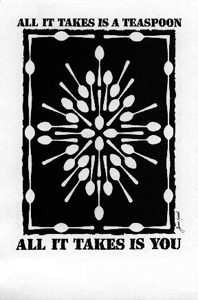 |
James Kiberd’s work as National Ambassador for the U.S. Committee/UNICEF |
 |
| S A V I N G T H E W O R L D ’ S C H I L D R E N | ||
|---|---|---|
| The past several years, working for UNICEF on behalf of the U.S. Committee for UNICEF has changed me as a person and as an artist. As an ambassador I’ve seen, heard, and more importantly, tasted, touched and smelled where UNICEF’s work is done. Where children are struggling to survive - that’s where UNICEF is. This is not something you visit. It’s something you live with. It’s caused me to question who I am and what I do. “What is art for?”... not historically or aesthetically or socially or philosophically but ethologically. An ethologist observes animals’ activity; a pattern of activity is identified as a behavior and that behavior is studied as a factor of survival. So, what is art for in terms of human survival? This question gets louder the more I work for UNICEF. Louder still as I go into the field where UNICEF often deals with basic survival issues. Is art a survival issue? For as long as humans are in groups, there is art made. | ||
That is what tonight is about for me - communal ritual. I want to celebrate the community that is UNICEF. To bring us together around images that are made as deeply felt sensual and emotional offerings in prayer and celebration for all human kind. UNICEF asks, “How is human kind doing? How is a community doing?” All we have to do is look at how the children are doing. UNICEF taught me that. I have been in the field and I have seen it. There is almost nothing UNICEF won’t do to help children - and they do it with almost nothing. I want to share one experience with you from my ambassadorial trip to South Africa, Ghana and Cameroon... a new experience of where and what home and family is. There had been a bit of skepticism about my desire to draw with the children I visited, but we did it anyway. On my first encounter with lives so different from my own, I focused mostly on the contrasts. It’s all so different! The people, the language, the landscape, the customs, the cooking, the scents - all so new to me! And in that contrasting, we learned things about each other and ourselves and grew closer. | ||
| Then to be with, to talk with, to play with the children we grew closer still. And then, to draw with the children (a big deal for many of them, their first time with colored pencils and a clean sheet of paper)... to draw with them, to share that quiet, intense place where one’s self goes onto the page. I had no idea what would be there. But what I discovered was this... what’s there is what’s there in me! We draw about the same things - our house, our family, the things we love to do, to feel, our friends, our dreams. Sure, there are differences. Their kitchen is a big black pot on three clay legs over an open fire. But what really was so different? The language is speaking, the landscape is earth, the customs are behavior, the cooking is food, the scents are smells - the people are human. The children have dreams, heroes and aspirations. They care about family, friends and growing things - just like me. We’re at home together. So tonight, as you meet each other, enjoy the fact that we are together the family of UNICEF... and what great things we are doing. I’m so proud to be a part of this family - I’m so proud of you. I offer “Prayers and Celebrations” for the UNICEF community. - James Kiberd |
||
| L I N K S T O U N I C E F I N F O R M A T I O N | ||
 • UNICEF
• UNICEF• Support Unicef • Unicef USA News In photo at right, 1995-96 Kiwanis President Eddie Sigurdsson presents the CEO of Morton Salt, Walter Becky, a print of James Kiberd’s artwork. Read the article Artist Acts to Save World’s Children from Kiwanis Magazine. |
||
 |
 |
 |
 |
 |
 |
back to the top
